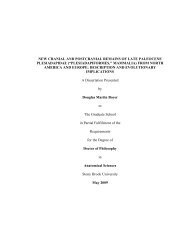Changes in nearest-neighbor associations in a captive group of ...
Changes in nearest-neighbor associations in a captive group of ...
Changes in nearest-neighbor associations in a captive group of ...
You also want an ePaper? Increase the reach of your titles
YUMPU automatically turns print PDFs into web optimized ePapers that Google loves.
266 McCann and Rothman<br />
In addition to proximity data, the behavior <strong>of</strong> each <strong>in</strong>dividual was recorded to<br />
determ<strong>in</strong>e whether the <strong>in</strong>fant <strong>in</strong>troductions had an effect on overall activity patterns<br />
<strong>of</strong> the adults and sub-adults. Individual behaviors were recorded and later <strong>group</strong>ed<br />
<strong>in</strong>to the general categories listed <strong>in</strong> Table 2. Although the frequencies <strong>of</strong> specific<br />
<strong>in</strong>dividual behaviors are not easily detected <strong>in</strong> this way, notable shifts <strong>in</strong> the rate <strong>of</strong><br />
general behavior categories can be detected. Thus, significant changes <strong>in</strong> an<br />
<strong>in</strong>dividual’s activity pattern can be surmised.<br />
Data Analyses<br />
All observations were recorded and analyzed us<strong>in</strong>g Micros<strong>of</strong>t Excel 7.0 and<br />
the statistical computer package M<strong>in</strong>itab (version 11.12). Determ<strong>in</strong>ation <strong>of</strong> the method<br />
<strong>of</strong> statistical exam<strong>in</strong>ation was obta<strong>in</strong>ed from Sokal and Rohlf [1981]. Percentage <strong>of</strong><br />
<strong>nearest</strong> <strong>neighbor</strong>s and distribution <strong>of</strong> behavior was calculated for each gorilla. When<br />
the gorilla was an adult, these values were compared before and after the <strong>in</strong>fants<br />
were <strong>in</strong>troduced <strong>in</strong>to the <strong>group</strong> us<strong>in</strong>g the Student t-test and the Mann-Whitney Utest.<br />
When the gorilla was an <strong>in</strong>fant, these values were compared before and after<br />
they were <strong>in</strong>troduced us<strong>in</strong>g the Mann-Whitney U-test. The data associated with the<br />
cluster and the amount <strong>of</strong> time spent with <strong>in</strong>fants were calculated <strong>in</strong>to a percentage<br />
and a 95% confidence test was used to determ<strong>in</strong>e significance. Nearest-<strong>neighbor</strong><br />
<strong>in</strong>dices were correlated to behavior us<strong>in</strong>g the G-test. All comparisons <strong>in</strong>volv<strong>in</strong>g distance<br />
were analyzed us<strong>in</strong>g the Student t-test. The frequency <strong>of</strong> behaviors before and<br />
after <strong>in</strong>fants were <strong>in</strong>troduced was analyzed us<strong>in</strong>g the G-statistical test. Comparisons<br />
<strong>of</strong> <strong>nearest</strong> <strong>neighbor</strong> and behavior between non-k<strong>in</strong> and k<strong>in</strong> were determ<strong>in</strong>ed by the<br />
Student t-test. The χ 2 test was performed to determ<strong>in</strong>e the probability <strong>of</strong> an <strong>in</strong>fant’s<br />
affiliation with each adult. The degree <strong>of</strong> relatedness <strong>of</strong> each <strong>group</strong> member was<br />
calculated accord<strong>in</strong>g to the coefficient <strong>of</strong> relatedness (r) [Hamilton, 1964]. An alpha<br />
level <strong>of</strong> significance <strong>of</strong> 0.05 was used <strong>in</strong> all statistical tests.<br />
RESULTS<br />
<strong>Changes</strong> <strong>in</strong> Behavior After the Infant Introduction<br />
Overall behavior patterns <strong>in</strong> the <strong>group</strong> did not change significantly after the<br />
<strong>in</strong>fants were added except for sub-adult female S1. S1 spent more time display<strong>in</strong>g<br />
locomotor behaviors after the <strong>in</strong>fants were added and less time rest<strong>in</strong>g (P ≤ 0.05, G<br />
= 39.56, df = 8). Additionally, S1 spent >18% <strong>of</strong> her time exhibit<strong>in</strong>g parental behav-<br />
TABLE 2. Behavioral categories recorded <strong>in</strong> study<br />
Category List <strong>of</strong> behaviors<br />
Feed<strong>in</strong>g Eat<strong>in</strong>g, forag<strong>in</strong>g, dr<strong>in</strong>k<strong>in</strong>g, regurgitat<strong>in</strong>g, and re-<strong>in</strong>gest<strong>in</strong>g.<br />
Locomot<strong>in</strong>g Stand<strong>in</strong>g, stand<strong>in</strong>g bipedal, walk<strong>in</strong>g, runn<strong>in</strong>g, and climb<strong>in</strong>g.<br />
Rest<strong>in</strong>g Sitt<strong>in</strong>g, rest<strong>in</strong>g, ly<strong>in</strong>g down, sleep<strong>in</strong>g, and nest<strong>in</strong>g.<br />
Self-care Pick<strong>in</strong>g nose, auto-groom<strong>in</strong>g, ur<strong>in</strong>at<strong>in</strong>g, and defecat<strong>in</strong>g.<br />
Sexual Solicit<strong>in</strong>g, copulat<strong>in</strong>g, and masturbat<strong>in</strong>g.<br />
Parental Carry<strong>in</strong>g/be<strong>in</strong>g carried and hold<strong>in</strong>g/be<strong>in</strong>g held.<br />
Affiliative Touch<strong>in</strong>g, groom<strong>in</strong>g, play<strong>in</strong>g, and play face.<br />
Agonistic-passive Avoid<strong>in</strong>g, cower<strong>in</strong>g, mouth<strong>in</strong>g, chest beat<strong>in</strong>g, and star<strong>in</strong>g.<br />
Agonsitic-active Approach<strong>in</strong>g, charg<strong>in</strong>g, chas<strong>in</strong>g, push<strong>in</strong>g, throw<strong>in</strong>g at, bluff charge, scream<strong>in</strong>g,<br />
pig grunt, and belch vocalization.






